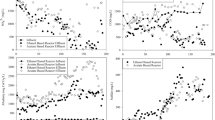Abstract
The toxicity potential and decolorization of three acid azo dyes (Acid Orange 6, Acid Orange 7, and Acid Orange 52) by methanogenic granular sludge from an anaerobic expanded granular sludge bed reactor was assayed. Complete bioreduction was found for all three azo dyes. Sulfanilic acid and 4-aminoresorcinol were detected from the decolorization of Acid Orange 6, sulfanilic acid and 1-amino-2-naphtol were detected from the reduction of Acid Orange 7, and sulfanilic acid and N,N-dimethyl-1,4-phenylenediamine (DMP) were found to be intermediates of Acid Orange 52 degradation. Sulfanilic acid and 1-amino-2-naphtol were persistent in the anaerobic conditions, whereas 4-aminoresorcinol was completely mineralized by anaerobic sludge and DMP was transformed into 1,4-phenylenediamine. Enrichment cultures obtained via consecutive passages on basal medium with only azo dye as a carbon and an energy source seemed to be morphologically heterogeneous. Baculiform and coccus cells were found when viewed under a light microscope. Cocci were joined in chains. Because anaerobic sludge contains sulfate-reducing bacteria and therefore may generate sulfide, azo dyes were tested for chemical decolorization by sulfide to compare rates of chemical and biologic reduction.
Similar content being viewed by others
References
McMullan, G., Meehan, C., Conneely, A., Kirby, N., Robinson, T., Nigam, P., Banat, I. M., Marchant, R., and Smyth, W. F. (2001), Appl. Microbiol. Biotechnol. 56, 81–87.
Manu, B. and Chaudhari, S. (2002), Bioresour. Technol. 82, 225–231.
Donlon, B., Razo-Flores, E., Luijten, M., Swarts, H., Lettinga, G., and Field, J. (1997), Appl. Microbiol. Biotechnol. 47, 83–90.
Stokar, Y. M. and Marechal, A. (1998), Dyes Pigments 37(4), 335–356.
Robinson, T., McMullan, G., Marchant, R., and Nigam, P. (2001), Bioresour. Technol. 77, 247–255.
Bechtold, T., Mader, C., and Mader, J. (2002), in Proceedings of the 19th IFATCC Congress, pp. 19–23.
Tan, N. C. G. (2001), PhD thesis, Wageningen University, Wageningen, The Netherlands.
Donlon, B. A., Raso-Flores, E., Field, J. A., and Lettinga, G. (1995), Appl. Environ. Microbiol. 61(11), 3889–3893.
Kalyuzhnyi, s., Sklyar, V., Mosolova, T., Kucherenko, I., Russkova, J., and Degtyaryova, N. (2000), Water Sci. Technol. 42(5–6), 363–370.
Kalyuzhnyi, S. and Sklyar, V. (2000), Water Sci. Technol. 41(12), 23–30.
van der Zee, F., Lettinga, G., and Field, J. A. (2001), Chemosphere 44, 1169–1176.
Author information
Authors and Affiliations
Corresponding author
Rights and permissions
About this article
Cite this article
Yemashova, N., Telegina, A., Kotova, I. et al. Decolorization and partial degradation of selected azo dyes by methanogenic sludge. Appl Biochem Biotechnol 119, 31–40 (2004). https://doi.org/10.1385/ABAB:119:1:31
Received:
Revised:
Accepted:
Issue Date:
DOI: https://doi.org/10.1385/ABAB:119:1:31




